Friday, December 24
Saturday, December 25
Sunday, December 26
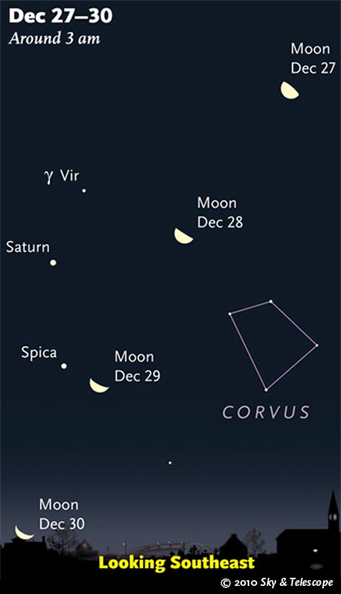
Stick your head out around 3 a.m., and the waning Moon guides your way to Saturn.
Sky & Telescope diagram
Monday, December 27
Tuesday, December 28
Wednesday, December 29
And don't miss Uranus, magnitude 5.8, currently 50 arcminutes to Jupiter's north-northeast. It looks even more un-starlike at high power.
Thursday, December 30
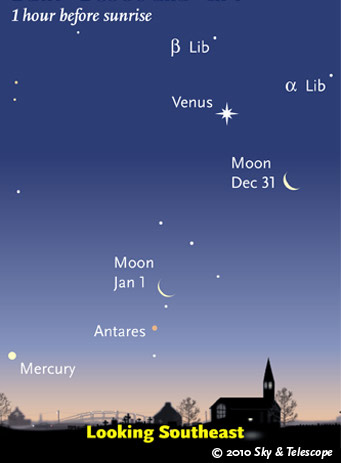
As the Moon wanes further, it points the way to Venus, Antares, and newly arrived Mercury.
Sky & Telescope diagram
Friday, December 31
Saturday, January 1
Sky at a Glance is now an iPhone app! Put S&T SkyWeek on your iPhone, iPad, or iPod Touch and get the above listings anytime, anywhere — with interactive sky maps! Tap a button to see the scene described, customized for your location worldwide. From there you can scroll the view all around the sky, zoom in or out, change to any time or date, and turn on animation. Go to Apple's iTunes store from your device and buy S&T SkyWeek — just 99 cents!
Want to become a better amateur astronomer? Learn your way around the constellations. They're the key to locating everything fainter and deeper to hunt with binoculars or a telescope.
For an easy-to-use constellation guide covering the whole evening sky, use the big monthly map in the center of each issue of Sky & Telescope, the essential magazine of astronomy. Or download our free Getting Started in Astronomy booklet (which only has bimonthly maps).
Sky Atlas 2000.0 (the color Deluxe Edition is shown here) plots 81,312 stars to magnitude 8.5. That includes most of the stars that you can see in a good finderscope, and typically one or two stars that will fall within a 50× telescope's field of view wherever you point. About 2,700 deep-sky objects to hunt are plotted among the stars.
Alan MacRobert
Once you get a telescope, to put it to good use you must have a detailed, large-scale sky atlas (set of charts). The standards are the Pocket Sky Atlas, which shows stars to magnitude 7.6; the larger Sky Atlas 2000.0 (stars to magnitude 8.5); and the even larger and deeper Uranometria 2000.0 (stars to magnitude 9.75). And read how to use your charts effectively.
You'll also want a good deep-sky guidebook, such as Sky Atlas 2000.0 Companion by Strong and Sinnott, or the more detailed and descriptive Night Sky Observer's Guide by Kepple and Sanner, or the classic if dated Burnham's Celestial Handbook.
Can a computerized telescope take their place? I don't think so — not for beginners, anyway, and especially not on mounts that are less than top-quality mechanically. As Terence Dickinson and Alan Dyer say in their Backyard Astronomer's Guide, "A full appreciation of the universe cannot come without developing the skills to find things in the sky and understanding how the sky works. This knowledge comes only by spending time under the stars with star maps in hand."
This Week's Planet Roundup
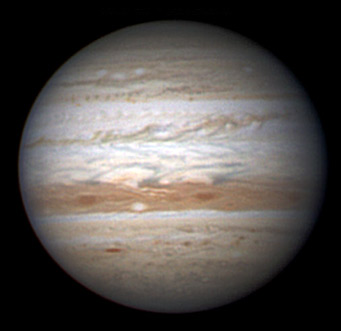
By December 13th, the dark markings issuing from the South Equatorial Belt Outbreak formed a very obvious, turbulent diagonal line most of the way around the planet. It's now detectable visually in almost any telescope capable of showing belts on Jupiter. Note also the activity in the North Equatorial Belt and the great blue festoons in the bright Equatorial Zone. Christopher Go took this image at 11:15 UT, when the central-meridian longitude (System II) was 267°. South is up.
Mercury emerges into dawn view and brightens late this week. On the morning of December 26th it's still very low and only magnitude +1.5, but by the 31st it's much higher and magnitude +0.3. Look for it in the east-southeast, about 60 to 45 minutes before your local sunrise time, very far to the lower left of bright Venus. Don't confuse Mercury with Antares, well to its right and more directly below Venus (for skywatchers at mid-northern latitudes).
Venus (magnitude –4.7) blazes as the "Morning Star" in the southeast before and during dawn. In fact Venus rises some two hours before the first glimmer of dawn (for mid-northern latitudes) — a weird UFO of a thing in the east-southeast.
Look for Saturn and Spica very far to Venus's upper right, and Arcturus even higher above Venus.
Mars is lost in the glow of sunset.
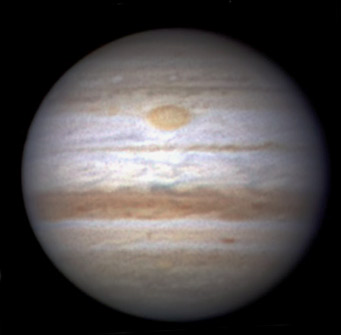
Jupiter's other side, on December 15th. The central-meridian longitude (System II) was 163°. South is up. Note the thin streamer of dark material all the way across the disk just above the bright Equatorial Zone. It's from the South Equatorial Belt Outbreak on the far side of the planet, now more than a month old.
Jupiter (magnitude –2.4, at the Pisces-Aquarius border) shines in the south during twilight and southwest later in the evening. It's the brightest starlike point in the evening sky, then sets by midnight. In a telescope Jupiter has shrunk to 40 arcseconds wide. Jupiter's South Equatorial Belt continues re-forming, as dark markings spread east and west all around the globe from the storm spot that broke out in the SEB's latitude a month and a half ago. The original outbreak site transits Jupiter's central meridian about 3 hours and 40 minutes after the Great Red Spot.
As for the Great Red Spot, it's near System II longitude 157°. Assuming it stays there, here's a list to print out of all the Great Red Spot's predicted transit times for the rest of this observing season.
Saturn (magnitude +0.8, in Virgo) rises around 1 a.m. and is high in the south-southeast before and during dawn, far upper right of brilliant Venus. Don't confuse Saturn with Spica below it.
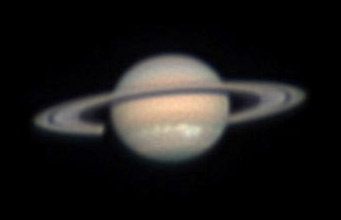
A view of Saturn's dramatic new storm, as recorded by Sean Walker on December 25, 2010, with a 12½-inch reflector and an Imaging Source CCD camera. South is up.
S&T: Sean Walker
In a telescope, Saturn's new white spot has grown big, long, and prominent! See our article, Saturn's New Bright Storm, which includes its predicted transit times.
Saturn's rings have widened to 10° from edge-on.
Uranus (magnitude 5.8) is only about 1° from Jupiter and closing.
Neptune (magnitude 7.9, in Capricornus) is still in the southwest right after dark. It shared the same telescopic view with 5th-magnitude Mu Capricorni. See our finder charts for Uranus and Neptune online or (with article) in the September Sky & Telescope, page 56.
"Science is built up of facts, as a house is with stones. But a collection of facts is no more a science than a heap of stones is a house."
— Henri Poincaré (1854–1912)
All descriptions that relate to your horizon — including the words up, down, right, and left — are written for the world's mid-northern latitudes. Descriptions that also depend on longitude (mainly Moon positions) are for North America. Eastern Standard Time (EST) equals Universal Time (also known as UT, UTC, or GMT) minus 5 hours.
To be sure to get the current Sky at a Glance, bookmark this URL:
http://SkyandTelescope.com/observing/ataglance?1=1
If pictures fail to load, refresh the page. If they still fail to load, change the 1 at the end of the URL to any other character and try again.
 0
0
Comments
You must be logged in to post a comment.